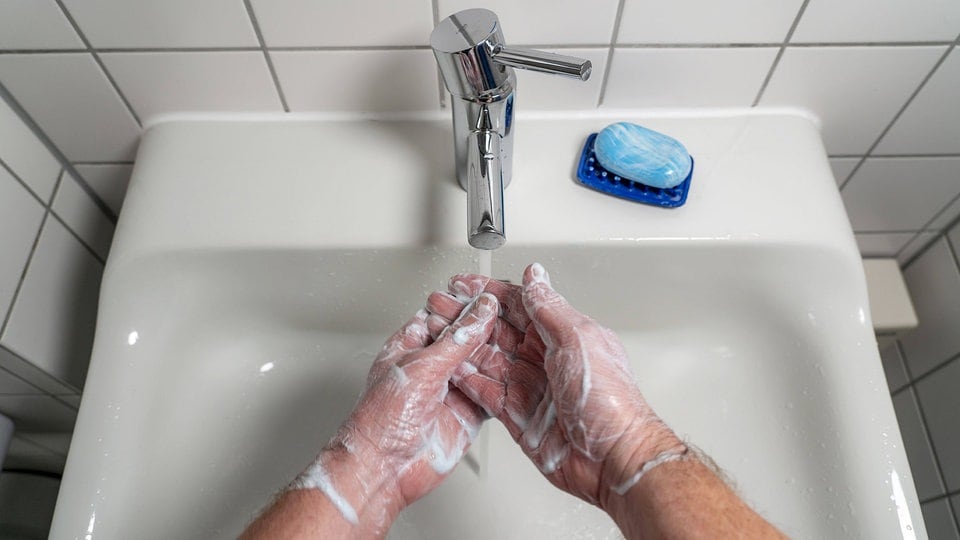
Already washed today? A short history of cleanliness
As long as there is no vaccine against the coronavirus, hygiene is the strongest weapon in the fight against the corona pandemic. Nothing beats washing your hands. But since when have we actually been doing this, how and why? A look back into the history of hygiene.
We scrub ourselves clean every day. The desire to be healthy and well-groomed is probably as old as humanity – “almost a natural reflex,” explains Prof. Thomas Schnalke, medical historian and director of the Berlin Medical History Museum at the Charité. The question, however, is when we consciously do this for hygienic reasons.
Public toilets since the Romans
Three and a half thousand years ago, the Greeks installed water pipes in their homes. And bathing was comfortable in the palace of Knossos on Crete. The Romans also had a highly developed culture of cleanliness two thousand years ago. In the bathhouses people cleaned themselves with perfumed oils and a scraper called a strigilis. There were even public toilets back then. In Ostia Antica, the ancient port city of Rome, business was carried out together – in ranks, in a very hygienic manner with flushing water.
Public thermal baths have even become synonymous with Roman culture in antiquity – wherever the ancient Romans appeared, thermal baths were also built. They were among the most sophisticated works of architecture at the time, because “bathing” was not just limited to simple body cleansing, but rather resembled an hour-long wellness procedure. This included steam baths, swimming, sweating, gymnastics, sunbathing, scrubbing and massaging – all spread across various rooms. In the Roman baths, social barriers were also blurred: Since almost everyone bathed naked, the usual status symbols such as a “senator’s toga” were literally not used. Even the emperors thought it appropriate to appear at the public baths from time to time.
Little cleanliness in the Middle Ages
The Middle Ages, a good thousand years later, are frowned upon as being hygienically unappealing – with urban sewers as breeding grounds for diseases. Chamber pots were emptied onto the streets, market waste was left lying around, pigs and chickens ran around freely everywhere. But in reality it wasn’t much different in ancient times either.
And so not everything and everyone was dirty in the Middle Ages. It was not uncommon for the knights to end up in public bathhouses. It was very busy there, in large communal bathrooms. However, when syphilis spread – a disease that is primarily transmitted through unprotected sexual intercourse – the bathhouses were blamed. Other plagues also struck Europe. Rat fleas spread the plague, and millions of people died in major epidemics. The strange consequence: people hardly washed anymore.
During the Rococo era, at the beginning of the 18th century, powder closed all pores – as a supposed protection against illness, just like clothing. Frequent washing was frowned upon. The bizarre theory at the time: Clogged pores keep the body’s fluids “in balance” and protect against invading diseases such as the plague and other epidemics. Those who could afford it rubbed expensive ointments and oils onto their skin. If necessary, dry cloths would also work instead of cleansing water.
Saufrei gets new momentum
With the Enlightenment came movement in cleanliness. Until then, hygiene in the broadest sense had been understood as general measures to maintain health, says Prof. Schnalke. As a result of scientific thinking, and especially in medicine in the 19th century, the aspect of cleanliness became increasingly important. Instead of inner balance, which was previously seen as central to a healthy life, the focus was now on external cleansing of the skin. From then on, cleanliness and pleasant smell stood for health.
Milestone in the history of hygiene
Until the first half of the 19th century, science still considered cleanliness and disinfection in medicine to be of secondary importance. Medical instruments were not cleaned before use and surgical aprons were rarely washed.
The groundbreaking observation that disinfection curbs the transmission of diseases was made by assistant physician Ignaz Semmelweis in 1845. He was working at the obstetrics clinic in Vienna at the time and observed “that there were obviously disease particles that were being carried by medical students from the dissection room to the obstetrics clinic were transmitted and led to increased mortality among patients, as well as the observation that epidemics, such as cholera, spread explosively through contaminated places,” explains medical historian Prof. Schnalke. From now on, Semmelweis’ students had to wash their hands with chlorine. The result: the death rate fell.
In the second half of the 19th century, the chemist Max von Pettenkofer finally recognized the connection between dirt and pathogens. As early as 1865 he held the first chair for hygiene in Germany.
A real hygienic era is being proclaimed in and by medicine. In the second half of the 19th century, not only ‘hygiene’ emerged as a separate medical subject. Proper hygiene exhibitions are also being organized and hygiene museums are being set up, like the one in Dresden.
Prof. Thomas Schnalke | Medical historian and director of the Berlin Medical History Museum at the Charité
Rediscovery of public hygiene
The bacterium was now known as a physically real enemy that could be combated with hygienic measures. Surgical instruments were now sterilized, doctor’s clothing was washed regularly, and masks and gloves were introduced. The scientific findings in the field of medical hygiene ultimately led to hygiene measures being taken in public life – such as hospital construction or cleanliness in market halls. The sense of personal hygiene was sharpened again, driven primarily by the doctor Johann Peter Frank. He advocated a fundamental improvement in hygiene in public buildings, better training for doctors and nurses and better financing of the health system.
20th century: Hygiene booms
In the 20th century there was lightning and flashing. Cleanliness and hygiene were very important. Everything had to be virtually germ-free – the body and the apartment. Soaps, cleaning products and detergents were widely advertised on television and the number of bathrooms per household increased. Food and clinical clinical hygiene played an increasingly important role.
Today, when we care for our bodies and wash our hands, there is a very long story behind it. However, according to Prof. Schnalke, the ongoing handwashing campaigns show how difficult it is to implement this behavioral exercise across the board in everyday life – a ritual that can save lives in Corona times.
About the medical historian Prof. Dr. Thomas SchnalkeHe is professor of medical history and medical museology and director of the Berlin Medical History Museum at the Charité. In 1993, the medical graduate completed his habilitation at the Erlangen University for the History of Medicine with a study on urban medicine in the German-speaking world in the 18th century. When he was appointed to Berlin in 2000, he began to engage more intensively with anatomical and pathological-anatomical specimen collections as well as with material aspects in the history of medicine and science. At the museum he was able to organize numerous exhibitions on medical-historical topics as well as on the interface between art and medicine.
more on the subject
MDR also reported on this topic on TV:MDR | February 8, 2018 | 10:05 p.m
CVs | February 18, 2016 | 11:00 p.m

Ethel Purdy – Medical Blogger & Pharmacist
Bridging the world of wellness and science, Ethel Purdy is a professional voice in healthcare with a passion for sharing knowledge. At 36, she stands at the confluence of medical expertise and the written word, holding a pharmacy degree acquired under the rigorous education systems of Germany and Estonia.
Her pursuit of medicine was fueled by a desire to understand the intricacies of human health and to contribute to the community’s understanding of it. Transitioning seamlessly into the realm of blogging, Ethel has found a platform to demystify complex medical concepts for the everyday reader.
Ethel’s commitment to the world of medicine extends beyond her professional life into a personal commitment to health and wellness. Her hobbies reflect this dedication, often involving research on the latest medical advances, participating in wellness communities, and exploring the vast and varied dimensions of health.
Join Ethel as she distills her pharmaceutical knowledge into accessible wisdom, fostering an environment where science meets lifestyle and everyone is invited to learn. Whether you’re looking for insights into the latest health trends or trustworthy medical advice, Ethel’s blog is your gateway to the nexus of healthcare and daily living.

